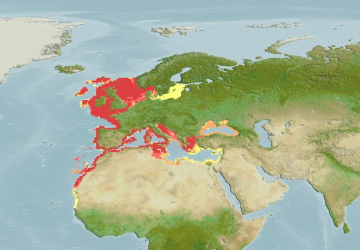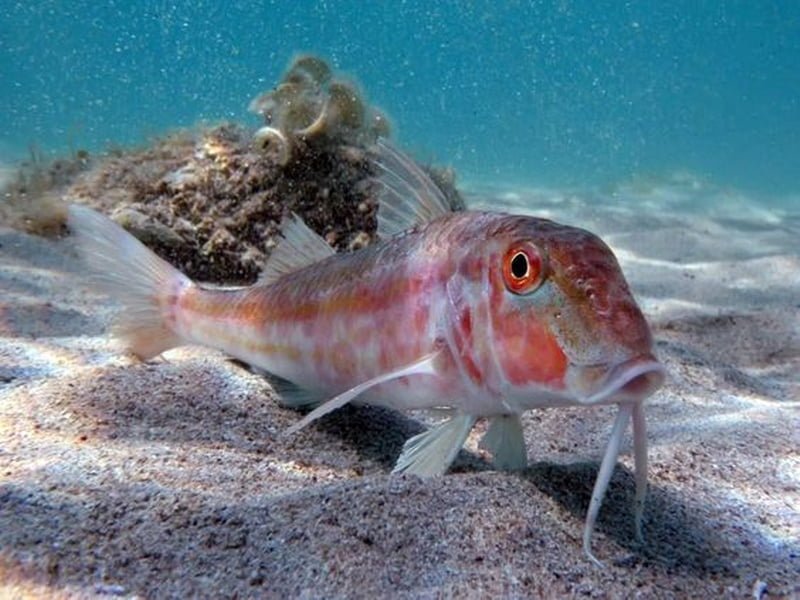Mullus Barbatus
– Red Mullet –


| Conservation status |
|---|
 Least Concern (IUCN 3.1)[1] |
| Scientific classification |
Mullus barbatus
Linnaeus, 1758[2]
| Kingdom: | Animalia |
| Phylum: | Chordata |
| Class: | Actinopterygii |
| Order: | Perciformes |
| Family: | Mullidae |
| Genus: | Mullus |
| Species: | M. barbatus |


Mullus barbatus (red mullet) is a species of goatfish found in the Mediterranean Sea, Sea of Marmara, the Black Sea and the eastern North Atlantic Ocean, where its range extends from Scandinavia to Senegal. They are fished, mostly by trawling, with the flesh being well regarded. The International Union for Conservation of Nature has assessed their conservation status as being of “least concern“.
Description
The red mullet can grow to a standard length of 30 cm (12 in), but a more common length is about half that. The body is somewhat laterally compressed.
The snout is short and steep and there are no spines on the operculum. The upper jaw is toothless, but there are teeth on the roof of the mouth and on the lower jaw. A pair of moderately long barbels on the chin do not exceed the pectoral fins in length. The first dorsal fin has eight spines (the first one tiny) and the second dorsal fin has one spine and eight soft rays. This fish is rose-pink, without distinctive markings on its fins.[5]
Its two white chin barbels are very characteristic: they contain tactile, olfactory and gustatory organs. They are able to detect prey in the mud: the fish can then dig them up in large mouthfuls. These barbs are equal to or shorter in length than the pectoral fins.
The head of Mullus barbatus is massive, with a steep, hooked profileright to the eyes. It does not have a tooth on the upper jaw, nor a thorn on the edge of the operculum. Its cheeks have three large scales, the smallest, colorless, being often torn off. Its scales are large and very deciduous. Its lateral line is well marked.
It has two well-separated dorsal fins, the first being colorless , with spiny rays. The caudal has no streaks.
In general, it is brownish in tone, sometimes pinkish, and lighter on the belly. But its coloring can vary according to the environment: beige with a dark horizontal line, starting from the eye, on the sand; dark and mottled, especially on the flanks, if it moves elsewhere. Intense colors, more common on fishmongers’ stalls than in water, may however indicate severe agitation or high depth. Red mullet is also paler and duller at night than during the day. This red hue is also heightened by flaking. The sides have silvery reflections, the belly is white. The fry are rather bluish in tone and look like sardines.
Taxonomy
This fish was first described in 1758 as Mullus barbatus by the Swedish zoologist Carl Linnaeus in his Systema Naturae. FishBase currently recognizes two subspecies, though the validity of M. b. ponticus is uncertain:[3][4]
- M. b. barbatus (red mullet) Linnaeus, 1758 (found throughout most of its range)
- M. b. ponticus (blunt-snouted mullet) Essipov, 1927 (found in the Black Sea and the Sea of Azov)
Biotope
The red mullet is found in the Mediterranean Sea, the Black Sea and the northeastern and central eastern Atlantic Ocean, where its range extends from Scandinavia southwards to Senegal, including Canary Islands, Azores and Madeira. It is a demersal fish and occurs at depths ranging from 10 to 328 m (30 to 1,080 ft)[1] over muddy, sandy or gravel bottoms.[5]
It is a gregarious and not very shy fish, very common in the Mediterranean, on the muddy bottoms of the continental shelf, between 100 and 300 m of depth, although the young, littoral ones, often live less deep. Usually, it stays in contact with the bottom. It can also adapt to sandy or pebble bottoms.
The fry live in open water and only become benthic from a size of 5 cm.
This fish is hardly ever encountered while diving.
Similar Species
Red mullet ( Mullus surmuletus ) is very similar to red mullet. It is found much more frequently in diving since it lives in depths ranging from the surface up to a hundred meters and in habitats typically frequented by divers. Its first dorsal is colored by yellow or brown bands. The profile of its head is slanted and it has only two large scales on its cheeks. Its barbs are longer than its pectoral fins. His eye is usually smaller. Finally, it is also less gregarious and more fierce than red mullet.
Juveniles of red mullet sometimes do not yet have a hooked snout, which does not make it easy to distinguish from red mullet.
The goatfish ( Pseudupeneus barberinus ) is also called the Red Sea mullet. It is present in the eastern Mediterranean, the Red Sea and the Indo-Pacific. It has barbs but it is beige with a black line from the eye to the tail.
Alimentation
The red mullet feeds on small animals, molluscs, worms and crustaceans, living in the interstices of the mud, which it locates thanks to its barbels and captures by vigorously searching the loose soil. This action sometimes leaves significant traces on the ground.
Planktonic larvae * feed on zooplanton *.
Reproduction
The sexes are separate. Sexual maturity is reached at two years, its size then around 17 cm. Reproduction takes place at night, from spring to summer. The laying takes place from May to August, on silt bottoms between 80 and 130 m, and there can be up to 100,000 eggs which hatch after three days.
Breeding takes place in the spring and summer, with spawning occurring in April and May in the Adriatic Sea, at depths between 60 and 70 m (200 and 230 ft). The larvae soon move to shallower depths and are pelagic, as are the juveniles at first. At a length of about 5 cm (2 in) the juveniles move to the coast and become demersal, often congregating in estuaries, and sometimes swimming a short distance upstream. Later they disperse to muddy, sandy or gravelly substrates, becoming sexually mature at a length of 10 to 14 cm (4 to 6 in) during their first year of life.[6]
Associated Life
As in the case of the red mullet, Mullus surmuletus , other fish are attracted by the excavations carried out by the red mullet, thus hoping to take advantage of the prey unearthed or put to flight (commensalism *).
The red mullet is carnivorous, the diet consisting mainly of polychaete worms, bivalve molluscs and crustaceans. The barbels are sensory organs and are used to help locate prey.[6] Both young and adult mullet are preyed on by various fish including the angler fish (Lophius piscatorius), the thornback ray (Raja clavata), the common stingray (Dasyatis pastinaca), the school shark (Galeorhinus galeus), the John Dory (Zeus faber) and the European hake (Merluccius merluccius).[6]
Various Biology
This fish often lives in groups. When in danger, the mullets erect their first ridge, probably to appear larger and to impress the possible predator. The barbs are then folded into notches under the head. The whole group fled.
Further Information
If in the Western Mediterranean, the red mullet is seldom seen by divers, this does not seem to be the case in the Eastern Mediterranean, and in particular in the Cyclades, where it is not uncommon to meet it at very shallow depth (1 to 2 m). He then lives close to the red mullet.
Mullet is mainly caught by trawling. Its firm and fine flesh has been highly sought after since Antiquity. It was then presented alive in a jar to enjoy its amazing color changes.
Fisherei
The flesh of the red mullet is much esteemed and it is the target of fisheries, especially in the Mediterranean Sea, Black Sea and northeastern and central eastern Atlantic Ocean. It is mainly caught by trawling, but also with trammel nets, gill nets and hook and line, and in artisanal fisheries with traps and spears. In the Mediterranean there are signs of overfishing, and many of the fish caught are shorter than 15 cm (6 in) in total length, and being under two years old, are not yet sexually mature. For conservation of the species in the Mediterranean, the breeding grounds and nursery areas need to be protected.[1]
It is also heavily fished off the coast of northwestern Africa. Here the fish are caught by local artisan fishermen as well as by foreign industrial fleets; they may be the targeted species or may be bycatch in hake, cephalopod or shrimp fisheries, but the catch statistics are not subdivided by species. There is also thought to be overfishing in the Black Sea. The fish is currently listed by the International Union for Conservation of Nature as being of “least concern” because it has a wide range, occurs at depths down to 328 m (1,080 ft) and is expanding its range northwards as a result of rising sea temperatures.[1]


















































































































































































































































































































































































